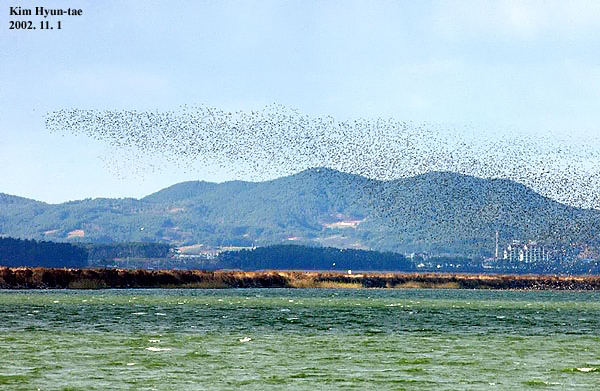Kim Su-Kyung, edited and amended by N. Moores


Period: : 1st November ~ 31st December 9:00a.m - 6:00p.m
Introduction
This pioneering "fair" is the first of its kind in South Korea, and though it follows on from the highly successful Reed Festival held in Suncheon Bay each year, it marks an enormous step forward in Korean wetland conservation. The fair is funded by Seosan City, a local government authority who should be congratulated both for their work and also for their apparent responsiveness to the advice of several excellent wetland and bird experts that work in the region.
The Fair is the first that aims to educate people about the relationship between birds, rice, wetlands and farmers, and has actively and successfully involved local people in the process. In a country with almost 1 million ha of rice-field (an area four times greater than that of remaining tidal-flat), which in turn support over 1 million waterbirds annually, such an initiative is as welcome as it is significant.
Background

Nearly 20 000 ha of Cheonsu Bay was reclaimed in the 1980s, creating two enormous reclamation lakes, surrounded by extensive rice-fields, owned and managed by Hyundai, the Korean industrial giant. Following reclamation, the area has proved increasingly important for ducks (especially Baikal Teal, with maxima probably in excess of 300 000) and geese, and has even been nominated to the Anatidae Network (under the Asia-Pacific Migratory Waterbird Strategy): sadly still the only such site nationwide. Although plans had been made to dredge significant parts of Lake A (the key loafing area for many waterbirds, and one of the best spots in the county for seeing Steller's Sea-eagle in winter), rapidly increased public awareness of the value of the site and active lobbying by local activists and experts seems to havepaid off. Seosan City is therefore now to be sincerely congratulated for creating some basic birdwatching facilities with a strong educational element, and organizing this two-month long promotion, with the overriding philosophy of conserving wetlands and birds through involving and supporting the local community.
The Festival
Following on from an international Anatidae workshop the fair was launched to encourage local people both to learn about species such as the Baikal Teal, and to become involved as e.g. guides, educating visitors about them and their basic ecololgy.

The event is controlled and well coordinated from a main exhibition hall (open between 9 am and 6 pm), where there is a photograph exhibition, various specimens, and the constant screening of a 5-minute long video of the Baikal Teals' famous evening flight. Near to the hall 70 ha of rice-field has been specially flooded (a project initiated by Dr. Lee Hansoo in Seosan in 2001, and encouraged by a national government biodiversity conservation program) and a birdwatching hide (one of the first of its kind in Korea) set up nearby, so visitors can see crowds of roosting and feeding geese and ducks.
To make the connection even clearer between bird conservation and rice-field management, bags of rice grown in fields supporting the geese are also on sale (at 2000 won per 1kg), with money from sales of these souvenir bags going to the Hyundai farmer's Association. This model of supporting conservation through purchase of rice grown in specially managed fields was first developed in Japan at Kabukuri Numa by the Japanese Wild Goose Protection Association: it has now reached Korea…offering enormous potential for good. With very limited natural floodplain remaining nationwide, rice-fields are the only viable habitat for a wide range of species: not only the Baikal Teal, but also e.g. Oriental White Stork and Hooded Crane: 2 further species that winter at Seosan. In addition to activities at and near the exhibition centre, between 11 am and 3 pm during the fair period there are regular shuttle buses running to the main lake.
To reduce disturbance to the birds there, entrance by private car to this main area has been restricted, and each bus group (led by a local guide), travels directly to two reed-screen hides, where closer views of the birds can be enjoyed.

And what birds! Either during the day, when the lake is smudged brown by an enormous raft of duck tens of thousands strong, or in the evening (between 5 pm and 5 40pm) when, from the main dyke visitors can witness one of the greatest birding spectacles in the world, as thousands and thousands of geese flight towards the lake for roosting, and the Baikal Teal flock lift up off the water in huge waves, moving to the surrounding rice-fields to feed at night. The spectacle is repeated at dawn, between 6 am and 7 am when the Baikals return in long, drawn out lines.



